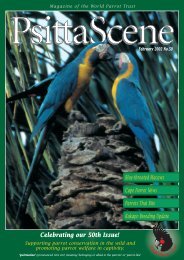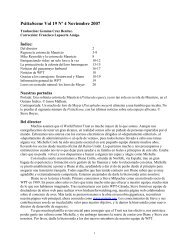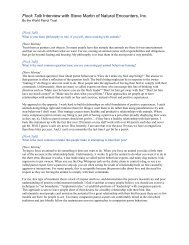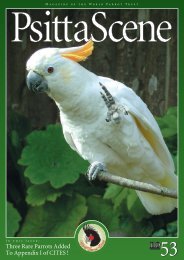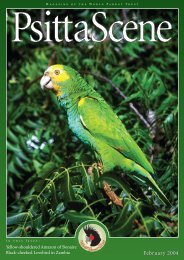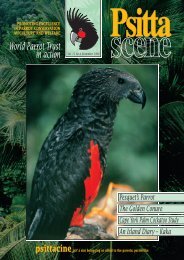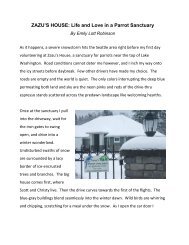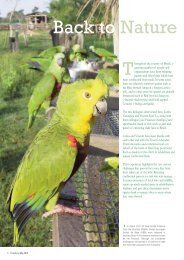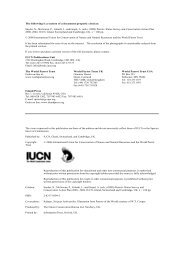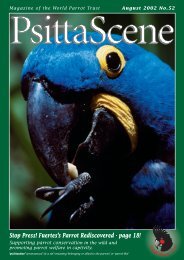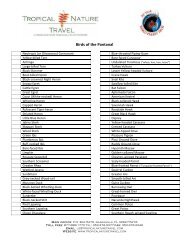PS 20 1 Feb 08.qxd - World Parrot Trust
PS 20 1 Feb 08.qxd - World Parrot Trust
PS 20 1 Feb 08.qxd - World Parrot Trust
Create successful ePaper yourself
Turn your PDF publications into a flip-book with our unique Google optimized e-Paper software.
Cameroon; terrible conditions in crowded boxes; flight cages built to house hundreds of birds that could not be immediately<br />
feathers in order to speed recovery before release.<br />
From Dr. Gino Conzo, DVM, Napoli, Italy<br />
At the beginning of December the <strong>World</strong> <strong>Parrot</strong><br />
<strong>Trust</strong> informed me about a very large seizure of<br />
African Grey parrots and put me in touch with<br />
Dr. Felix Lankester at Limbe Wildlife Centre to<br />
provide emergency advice.<br />
As the weeks went by and all the releasable birds<br />
were freed, it became clear that the remaining<br />
birds needed their damaged feathers removed.<br />
This long and tedious procedure was urgently<br />
required to speed the growth of new feathers<br />
and allow the birds to be released much more<br />
quickly. When the <strong>Trust</strong> asked me if I would be<br />
willing to travel to Limbe to assist, I gladly<br />
accepted. On January 16, I travelled to<br />
Cameroon with Mario D'Angelo, an Italian<br />
volunteer. Our bags were packed with<br />
antibiotics, latex gloves, syringes, suture thread,<br />
and a large supply of vitamin supplements<br />
donated by Gea International. A supply of hard<br />
to obtain injectable Doxycycline had been<br />
procured by the <strong>Trust</strong> in Switzerland and<br />
shipped by DHL to Limbe.<br />
We understood right away, as the hot and humid<br />
weather greeted us at our arrival in Douala, that<br />
our task would not be simple. This is the dry<br />
season in Cameroon, with temperatures<br />
averaging 85°F (30°C) with high humidity. Still,<br />
despite the discomfort, our first morning<br />
showed us a rich and seemingly intact nature.<br />
We received a warm welcome from Felix and all<br />
the staff at the LWC, and started to work<br />
immediately in an area that had been set up for<br />
us close to the two aviaries where the parrots<br />
are kept.<br />
It turned out that most of the flight feathers<br />
of all the birds were either cut or broken, or<br />
covered with the glue used to trap them, but<br />
the birds were otherwise in good nutritional<br />
condition. One by one we caught and<br />
anaesthetized each parrot with Isofluorane,<br />
removed damaged feathers with surgical<br />
tweezers, and medicated the follicles to prevent<br />
infection. This was how we preceded, bird after<br />
bird, all day for over five days. I was very<br />
grateful for Mario's help as the heat, the<br />
humidity and the insects didn't allow me to<br />
proceed as quickly as I would have liked to. At<br />
some point we started taking turns plucking the<br />
birds, so that we could each rest for a while or<br />
take care of something else.<br />
As each bird was anaesthetized, it received a<br />
general health check. About twelve birds had<br />
open wounds on their chests that appeared to<br />
be old and caused by hard falls. They were<br />
medicated and placed in smaller cages. Some will<br />
probably need surgery to reduce the size of the<br />
wound and speed their recovery. Four birds had<br />
string tied to a leg or a ring, as they were likely<br />
used as trapping lures.<br />
Our work day started at 8 am and continued<br />
with no breaks until 5 pm. We made sure to<br />
leave the birds alone when there were still a<br />
couple of hours of daylight before sunset, so<br />
that they could eat, as they wouldn't touch any<br />
food in our presence. Their diet consists of<br />
fruits, African palm nuts, and a mash made with<br />
corn and cassava flour, to which we advised the<br />
addition of cooked beans. The mash is<br />
medicated with 1% Doxycycline - to treat the<br />
Chlamydiosis that was previously diagnosed and<br />
to prevent infection in the feather follicles - and<br />
Phytotherapic supplements containing vitamins,<br />
amino acids, and minerals to help stimulate the<br />
growth of the new feathers.<br />
We were also able to provide other advice to<br />
give these parrots the best chance of successful<br />
recovery and eventual release. We advised<br />
modifications to the aviaries such as soft<br />
bedding like straw or other materials to reduce<br />
the traumatic effects of falls since many of the<br />
parrots are unable to fly. We also suggested they<br />
substitute the metal food and water containers<br />
with others made with safer materials, to lower<br />
the height of the perches, and to shield the<br />
aviaries with palm leaves or other materials to<br />
create a visual barrier between the birds and the<br />
visitors and reduce their stress.<br />
The Limbe staff were also trained on the best<br />
ways to handle the parrots, on how to medicate<br />
them and on how to perform small medical<br />
procedures.<br />
All in all it was a great experience, not easy but<br />
very rewarding. We were able to treat all of the<br />
birds and we are looking forward to the day<br />
when they will be set free.<br />
TTo learn more or to contribute to this<br />
effort email uk@worldparrottrust.org<br />
or visit www.parrots.org and click<br />
this link:<br />
<strong>Feb</strong>ruary <strong>20</strong>08 PsittaScene 5




